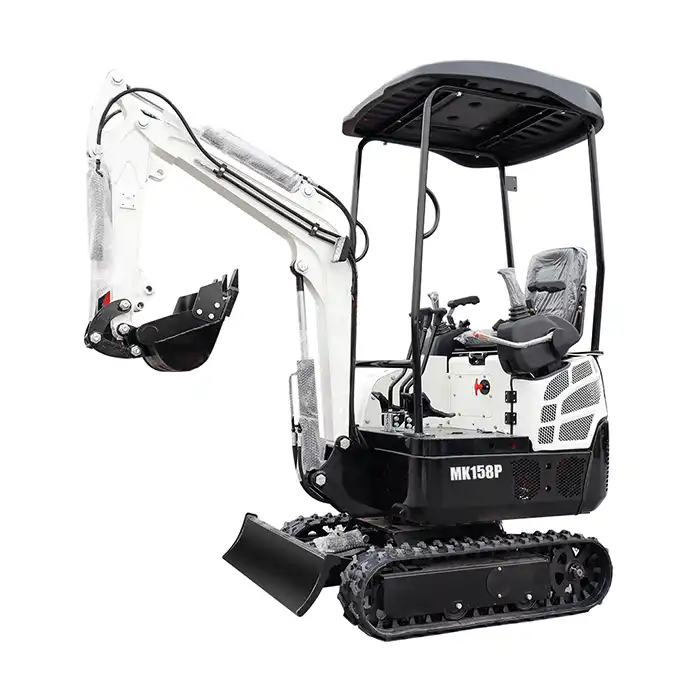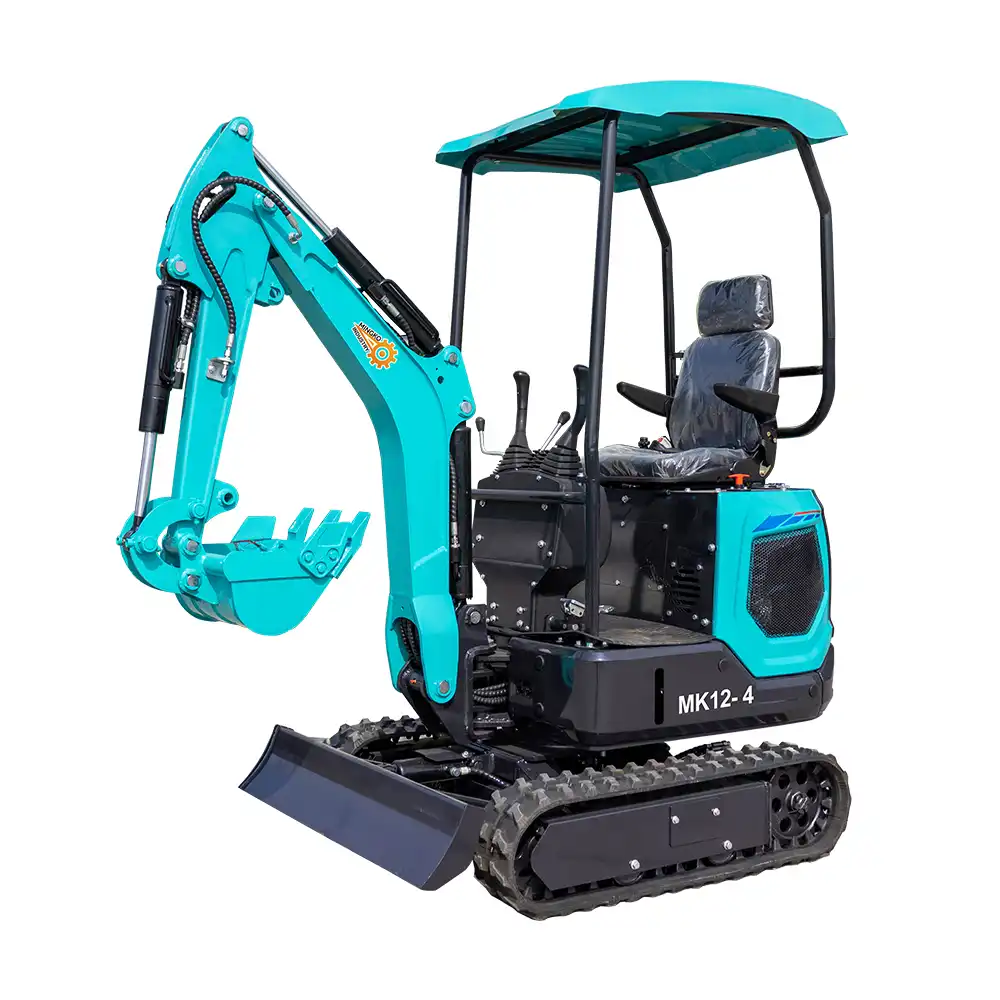Size and Weight Comparison
Dimensions and Footprint
The most obvious difference between mini excavators and midi excavators lies in their size. Mini excavators, as the name suggests, are compact machines designed for smaller spaces and lighter work. They typically range from 0.75 to 8 tons in weight and have an operating width of 2 to 6 feet. These diminutive diggers are perfect for navigating tight spaces and working in urban environments where space is at a premium. Midi excavators, on the other hand, occupy the middle ground between mini excavators and full-sized excavators. They generally weigh between 8 and 20 tons and have an operating width of 6 to 8 feet. While larger than their mini counterparts, midi excavators still offer a degree of maneuverability that full-sized excavators can't match.
Transportation and Mobility
The compact size of mini excavators makes them incredibly easy to transport. They can often be towed on a trailer behind a standard pickup truck, eliminating the need for specialized transportation equipment. This ease of mobility allows contractors to move mini excavators quickly between job sites, reducing downtime and increasing efficiency. Midi excavators, while still more portable than full-sized excavators, typically require larger trucks or trailers for transportation. Their increased size and weight mean that moving them between job sites can be more challenging and may require additional planning and resources.
Site Access and Maneuverability
Mini excavators excel in tight spaces and areas with limited access. Their compact design allows them to navigate through narrow gates, between buildings, and even indoors in some cases. This makes them ideal for residential construction, landscaping, and urban renovation projects where space is limited. Midi excavators, while less maneuverable than mini excavators, still offer good mobility for their size. They can access most construction sites and are particularly well-suited for medium-sized commercial projects or larger residential developments where more power is needed but space isn't as restricted as in urban settings.
Power and Performance Capabilities
Engine Power and Hydraulic Systems
The power output of mini excavators typically ranges from 10 to 60 horsepower, depending on the model and size. Their hydraulic systems are designed for precision and efficiency, allowing operators to perform delicate tasks with accuracy. While not as powerful as larger machines, mini excavators offer sufficient strength for a wide range of light to medium-duty tasks. Midi excavators boast more substantial engine power, usually ranging from 50 to 150 horsepower. This increased power translates to greater digging force, higher lifting capacities, and the ability to handle more challenging terrain. The hydraulic systems in midi excavators are more robust, allowing for faster cycle times and improved multitasking capabilities.
Digging Depth and Reach
Mini excavators generally have a digging depth of 5 to 12 feet and a reach of 12 to 21 feet. These specifications make them suitable for tasks such as digging foundations for small structures, creating trenches for utilities, or landscaping work that doesn't require extensive earth moving. Midi excavators offer significantly greater digging capabilities, with depths ranging from 10 to 20 feet and reaches extending from 20 to 30 feet. This increased range allows midi excavators to tackle larger excavation projects, deeper foundations, and more extensive earthmoving tasks that would be beyond the capabilities of a mini excavator.
Lifting Capacity and Attachments
The lifting capacity of scaled down excavators is regularly constrained to around 1,000 to 3,000 pounds, depending on the model. While this is adequate for numerous light-duty errands, it can be a constraining figure for more requesting jobs. Mini excavators can oblige a assortment of connections, counting buckets, wood screws, and water powered hammers, but the estimate and control of these connections are actually constrained by the machine's capabilities.
Midi excavators offer considerably higher lifting capacities, regularly extending from 3,000 to 15,000 pounds or more. This expanded quality permits them to handle heavier materials and bigger connections with ease. Midi excavators can be prepared with a more extensive extend of more effective connections, counting bigger buckets, water powered breakers, and indeed specialized apparatuses like tree spades or concrete crushers.
Applications and Suitability for Different Projects
Residential and Small-Scale Construction
Mini excavators are the go-to choice for residential and small-scale construction projects. Their compact size and maneuverability make them ideal for working in tight spaces around homes and in urban environments. They excel at tasks such as:
- Digging foundations for home additions
- Creating landscaping features like ponds or retaining walls
- Installing septic systems or underground utilities
- Clearing small lots or preparing sites for construction
The low ground pressure of mini excavators also minimizes damage to existing lawns and landscaping, making them a favorite among homeowners and landscapers alike.
Commercial and Medium-Scale Projects
Midi excavators shine in commercial and medium-scale construction projects where more power and capacity are required, but the job site isn't large enough to justify a full-sized excavator. These versatile machines are well-suited for:
- Excavating foundations for small to medium-sized buildings
- Creating larger-scale landscaping features
- Digging deeper trenches for utility lines or drainage systems
- Demolition work on smaller structures
- Road construction and maintenance tasks
The increased power and reach of midi excavators make them more efficient for these larger tasks, allowing projects to be completed more quickly than with mini excavators.
Specialized Applications
Both mini and midi excavators have found niches in specialized applications beyond traditional construction work. Mini excavators, with their light footprint and precise control, are often used in sensitive environments such as:
- Archaeological excavations
- Indoor demolition or renovation work
- Greenhouse or nursery operations
- Cemetery and monument installations
Midi excavators, with their greater power and versatility, are frequently employed in more demanding specialized roles, including:
- Forestry operations for clearing and site preparation
- Mining and quarrying support tasks
- Waste management and recycling facility operations
- Environmental remediation projects
The choice between a mini excavator and a midi excavator for specialized applications often comes down to the specific requirements of the task at hand, balancing factors such as required power, site access, and environmental impact.
Conclusion
In conclusion, the choice between a smaller than expected excavator and a midi excavator depends on the particular needs of your project. Mini excavators exceed expectations in tight spaces and light-duty assignments, whereas midi excavators offer more control and flexibility for bigger ventures. Consider variables such as work location conditions, required burrowing profundity, and lifting capacity when making your decision. If you need to get more data around this item, you can contact us at sales@mingkomach.com.

_1729500664700.webp)








